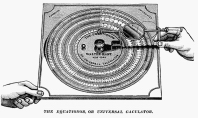
Click to view
The Equationor, or Universal Calculator
This ingenious instrument invented by Walter & Hart of New York is a universal calculating machine designed for practical service in the office, counting-room or shop for the rapid and accurate solution of arithmetical problems, other than those requiring addition or subtraction. The invention is the result of long and careful study, and in its present form exhibits mechanical ingenuity of high order.
The basis of the invention is the slide-rule, of which the inventor has adopted the fundamental idea, but his so simplified, extended, and otherwise modified it, that one is able by its use to solve with equal readiness and accuracy the most difficult and the most simple problems. The number and variety of operations which it is capable of performing, render it equally servicable in the counting-room, the office, the machine-shop, and the study.
The appearance of the instrument is shown in the accompanying cuts it is 8 1/2 inches square and packs in a box 1 1/2 inches deep. The scales differ in color to facilliate reference. The operative parts of the machine are constructed wholly of metal; the wooden base to which it is attached serves to stiffen it and a magnifier is suitably mounted in connection with it, to facilitate the reading of the finer divisions of the scales.
The following examples given by the inventor will exhibit the capabilities of the equationor: "If an apple costs two cents, what would five apples cost? is a problem requiring no great mental effort to solve. But if 8 1/2 apples cost 7 1/4 cents, what would 13 3/10 apples cost? would require considerable figuring. With the equationor this problem is as easily and quickly solved as the other. At the same instant the cost of not only the 13 3/10 apples, but any other number of apples at the same ratio is given. To find the interest on $100 for one year at 6 per cent is easy; but to find the interest on 162.40 for 27 days at 5 7/10 per cent is more difficult. With the equationor the second problem is as easy of solution as the first, and at the same time the interest for any other number of days is given. A merchant has a stock comprising a thousand articles at different prices. He wishes to mark all down, say 12 1/2 per cent. A single setting of the equationor will show the new price for each article."
The foregoing are by no means the most difficult or complex problems that may rapidly be solved by the use of this remarkable instrument. One feature that is of interest to note on account of its obvious utility is that it exhibits at a glance, numbers, with their squares cubes and reciprocals. To use the instrument, it is not necessary for the operator to change his usual methods of solving arithmetical questions, the same multipliers and divisors will be employed as in the usual menial operations, only they are applied in the instrument, and the mind is relieved of the drudgery of doing the actual work or calculation, while the time saved is of no less inportance,
A book of instructions accompanies the equationor, which contains the few rules that are required to learn the use of the instrument. These are chiefly instructions how to set the scales and to move the guide. Those who are accustomed to the use of the slide-rule, will comprehend the instrument without special instruction, and others will be able to master it without difficulty. In addition to the simple directions named above, the book gives instructions in the use of constants, etc., by which arithmetical work may be greatly abbreviated. The instrument is manufactured by the Equationor Co., 114 Liberty Street, New York.